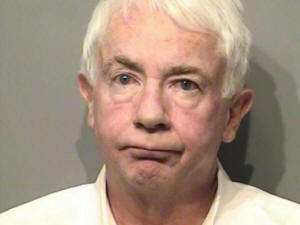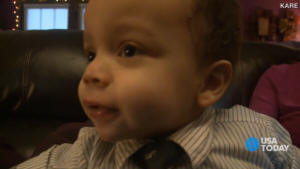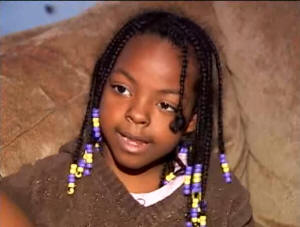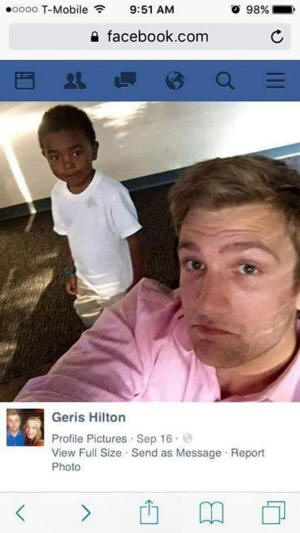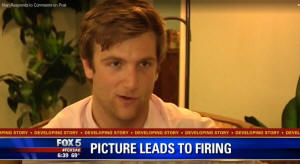Harsh discipline isn't colorblind.
By Stacey Patton
October 28, 2015
NOTICE: THIS WORK MAY BE PROTECTED BY COPYRIGHT
YOU ARE REQUIRED TO READ THE COPYRIGHT NOTICE AT THIS LINK BEFORE YOU READ THE FOLLOWING WORK, THAT IS AVAILABLE SOLELY FOR PRIVATE STUDY, SCHOLARSHIP OR RESEARCH PURSUANT TO 17 U.S.C. SECTION 107 AND 108. IN THE EVENT THAT THE LIBRARY DETERMINES THAT UNLAWFUL COPYING OF THIS WORK HAS OCCURRED, THE LIBRARY HAS THE RIGHT TO BLOCK THE I.P. ADDRESS AT WHICH THE UNLAWFUL COPYING APPEARED TO HAVE OCCURRED. THANK YOU FOR RESPECTING THE RIGHTS OF COPYRIGHT OWNERS.
Stacey Patton is a journalist, creator of Spare the Kids and author of "That Mean Old Yesterday: A Memoir."
Richland County, S.C., Sheriff's Deputy Ben Fields was called in to Spring Valley High School to remove a student. A classmate filmed the deputy slamming the student to the ground and dragging her through the classroom. (Reginald Seabrooks/YouTube)
In 1920, W.E.B. DuBois wrote: “There is no place for black children in this world.” Almost a century later, that remains true. Too often, to grow up black in the United States is to live in a perpetual state of vulnerability to the brutality of racism: People fear you, and you know there is no safe place for you. For many white children, the future is one of hope and endless possibilities. How can black children have hope, how can they dream, when they’re unable to feel safe, secure and loved by society?
The daily incidents are startling reminders of how far we have to go to secure a post-racial future. Black kids have been slapped on a plane for crying, verbally assaulted by racists on a school bus, terrorized at a birthday party by armed white men carrying Confederate flags, had their hair cut off in front of the class by a teacher, called “feral” in a viral, racist social media post, and assaulted by police at pool parties.
That precariousness in black children’s lives was on display again with this week’s viral video of a white cop brutally assaulting a black student in a Spring Valley, S.C., classroom. Many angry black viewers have been vocal on social media, reflecting a weary frustration: Just how much more of this are we expected to take?
In reality, though, this is not an isolated incident. This kind of harsh discipline has been the reality of growing up black and quasi-free in the United States for more than a century. What happened in Spring Valley isn’t an isolated individual attack on a black child; it’s an example of what our racist society does to black children far too often.
Like a growing number of schools across the country, Spring Valley High School in Richland County, S.C., has opened its doors to the police, with Ben Fields, a 34-year-old, hulking senior deputy in the sheriff’s department, patrolling its hallways as the school’s resource officer.
Despite lawsuits against him for excessive force, Fields had been entrusted by the school to protect students and make sure the learning environment was safe. But no one protected the 16-year-old black girl whom he grabbed by the neck and threw to the floor while she sat silent at her desk. No one protected her from being dragged and tossed across the floor like a ragdoll, forced into handcuffs and arrested.
Fields was called to the classroom to discipline the student, who — depending on which account you listen to — was either verbally disruptive, chewing gum, quiet or not bothering either her classmates or teacher. In other words, she was behaving like a normal teenager. But in the video, it appears she was treated like a criminal, a piece of trash that needed to be tossed aside without any regard for her feelings or rights. (Fields, meanwhile, will reportedly be fired on Wednesday.)
South Carolina is one of 19 states that still allow children to be whacked with wooden boards in schools for minor infractions, such as chewing gum, being late to class, talking back to a teacher, failing to do homework, violating the dress code, going to the bathroom without permission or more serious transgressions such as fighting. And like so much discipline in the United States, that punishment is often meted out disproportionately to black children. According to a survey from the Education Department’s Office of Civil Rights, black children made up 18 percent of our nation’s students but accounted for 35 percent of reported cases of corporal punishment in 2012. A 2014 report from Indiana University’s Equity Project found that black students are likely to be disciplined more frequently than their white peers, even though there’s no significant difference in behavior between the groups.
That’s often true whether it’s white adults or black adults hitting children. In April 2014, the Nation reported on the small town of Lexington, Miss., a state where 64 percent of all paddled students are black. There, the magazine found that most wielders of the paddle and vocal defenders of the practice are black educators. In Holmes County, a poor district where 99 percent of the students are black, white and black educators alike hit kids in day care and pre-school with pencils and rulers. Elementary and high school employee handbooks in that county call for the wooden paddle to be up to 30 inches long, half an inch thick, and from 2 to 3 inches wide. The teachers, according to the Nation, tell misbehaving students to “talk to the wood or go to the hood,” which means choose between being paddled or suspended from school.
The ACLU found that while corporal punishment rates in public schools have declined over the last 30 years, a disproportionate number of black students continue to be hit by teachers and principals. Data from the Education Department show that, as with suspensions and expulsions, black children are far more likely to be targeted for paddling than white students.
Dennis Parker, director of the ACLU’s Racial Justice Program, examined school-based paddling and concluded that it not only negatively affects children, but also serves as the first stage in what’s known as the school-to-prison pipeline. His team found that students of color, especially black girls, are far more likely to be paddled than their white peers.
“So many of the problems in discipline disparities are the result of this idea of what is perceived to be threatening,” Parker told me. “People respond to black children differently and are more likely to read behaviors as being disrespectful and insubordinate. Teachers are more likely to punish black children because they are not aware of their own biases and how those biases affect the ways they interact with students.”
Parker’s examination of records from Mississippi schools found that white students tended to be paddled for infractions, such as drugs, vandalism or bringing weapons to school. Black students were punished for things like rolling their eyes, talking back, questioning a teacher or excessive noise.
“These are behaviors that involve someone’s perception of disrespect, and they are not divorced from race,” he said. In that context, hitting can be seen as not only acceptable, but necessary.
In 2014, the Children’s Defense Fund reported that more than 800 children were being hit each day at school, totaling close to 200,000 instances of corporal punishment a year. The ACLU and Human Rights Watch report that school paddlings send thousands of students to seek medical treatment for welts, bruises and broken bones. The long-term effect of this so-called tough love, according to the report, is that many children are becoming angry and lashing out at teachers and other students, rather than improving behavior. Some students become depressed, withdrawn or disengaged from school as a result; others seem resigned to the constant violence, accepting it as a fact of their daily lives.
As the Spring Hill video demonstrates, black girls are common targets. Earlier this year, the African American Policy Forum and Columbia Law School’s Center for Intersectionality and Social Policy Studies released a report that found girls of color face much harsher school discipline than their white peers, citing numerous examples of excessive disciplinary actions against young black girls.
The most recent federal data cited in the report reveals that nationally black girls were suspended six times more than white girls, while black boys were suspended three times as often as white boys. In New York, there were more than 10 times as many disciplinary cases involving black girls as those involving their white counterparts, and the number of cases involving black boys was six times the number of those involving white boys, though there were only twice as many black students as white students.
Our states require school employees to report suspicions of child abuse at home. So why do so many of them allow and even encourage the same employees to hit children with wooden boards, placing them at risk for physical and psychological harm?
We imagine schools as places free from violence, where children are supposed to learn how to think, how to communicate, how to interact socially, and grow intellectually so they can become good citizens. So why are so many of them also places of metal detectors, paddles and aggressive cops who will toss a student across the room for being a teenager while black?
And yet the immediate response from some to the South Carolina incident — including Richland County Sheriff Leon Lott — has been to blame this child for being brutalized by a grown man.
No wonder that so many of our kids grow up expecting to be victims of brutality. No wonder that the kids in that classroom sat quietly, eyes downcast and frozen with fear as their classmate was attacked. The daily message from cops, principals, teachers and even from parents who tolerate this system by granting administrators permission to paddle their kids is clear: The world can beat you, attack you — even kill you — and it’s possible that nobody will dare, or care enough, to intervene. Everyone can assault you. You have no right to bodily integrity. No right to freedom of expression. You are never innocent; you are perceived as hostile, dangerous, and a threat to be beaten into submission. There is still no place for black children in this world.

